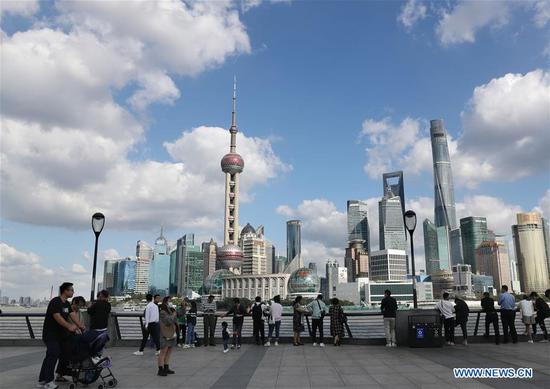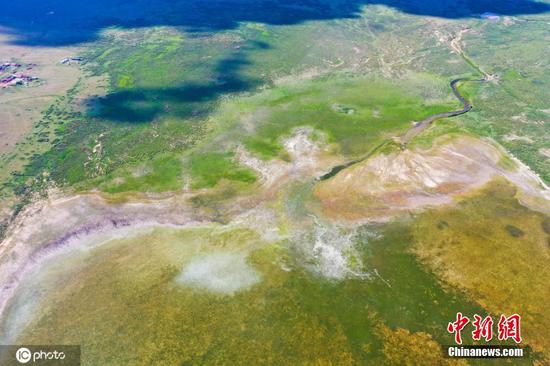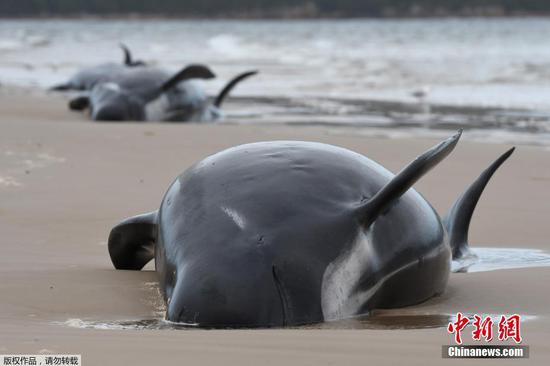Global economy is on track to experience a deep recession in 2020 amid the ongoing COVID-19 pandemic, with China being the only major economy that will see growth this year, the International Monetary Fund (IMF) said Tuesday.
In its latest World Economic Outlook (WEO) report, the multilateral lender revised up the 2020 forecast for global economy to a contraction of 4.4 percent. Despite the upward revision, the IMF said the ascent out of this crisis is likely to be "long, uneven and highly uncertain."
Economists believe that China's better-than-expected recovery -- boosted by containment of the virus, government spending and strong exports -- has spillover effects upon its neighbors and trading partners, and will support global economy's "difficult climb" going forward.
Meanwhile, resurgence of the virus poses downside risk to the global economic outlook, calling for enhanced multilateral cooperation to end this health crisis so as to ensure a sustained recovery.
LONG, UNEVEN, UNCERTAIN ASCENT
In its newly released WEO, the IMF continues to project a deep recession in 2020. Global output is projected to shrink by 4.4 percent, 0.8 percentage point above its June forecast.
"This upgrade owes to somewhat less dire outcomes in the second quarter, as well as signs of a stronger recovery in the third quarter, offset partly by downgrades in some emerging and developing economies," IMF Chief Economist Gita Gopinath said at a virtual press briefing Tuesday during annual meetings of the World Bank Group and the IMF.
The better-than-expected recovery is largely due to "extraordinary policy measures," which has put a floor under the world economy, IMF Managing Director Kristalina Georgieva said in a recent speech.
According to IMF estimation, governments across the globe have provided nearly 12 trillion U.S. dollars in fiscal support to households and firms, along with "unprecedented" monetary policy actions.
"This crisis is, however, far from over," Gopinath said. The ascent out of this calamity is "likely to be long, uneven, and highly uncertain."
In a remote video interview on Tuesday afternoon, the IMF chief economist told Xinhua that global recovery is expected to be strong in the third quarter, but it could slow down going forward.
"Because we are still living with the pandemic in many parts of the world, that is going to slow the recovery because especially contact-intensive services sectors will not recover fully as long as the pandemic is not under control," Gopinath said.
There remains tremendous uncertainty around the global economic outlook with both downside and upside risks, according to the WEO report. Downside risks include resurgence of the virus, growing restrictions on trade and investment, as well as rising geopolitical uncertainty.
"We are very concerned about possible second waves," Gopinath told Xinhua. "And if indeed there is a serious second wave, which leads to much more widespread containment measures and lockdown, then that certainly will be a big downside risk to our forecast."
CHINA'S RECOVERY FASTER THAN EXPECTED
According to the latest WEO report, China's economy is expected to grow by 1.9 percent this year, the only major economy that will see growth this year. It is 0.9 percentage point above the June forecast.
The upward revision for China resulted in part from a better-than-projected performance in exports, Gopinath noted. "The demand for medical equipment and for office equipment to work from home, that's been high. And China's exports have gone up because of that," she said.
A second factor, she continued, is the strong stimulus from public investment in infrastructure. "That also surprised on the upside."
The World Bank, meanwhile, has recently projected China's economy to grow by 2.0 percent this year, up from the 1-percent growth projection in June, according to the October 2020 Economic Update for East Asia and the Pacific.
The growth will be boosted by government spending, strong exports, and a low rate of new COVID-19 infections since March, but checked by slow domestic consumption, the World Bank said.
A recent CNN report noted that China built its relatively quick recovery through several measures, including "stringent lockdown and population tracking policies intended to contain the virus."
Highlighting the government's infrastructure spending and cash incentives to boost consumption, the report said "the payoff has been evident," as tourism and spending rebounded during the eight-day Golden Week holiday.
Geoffrey Garrett, dean of University of Southern California (USC) Marshall School of Business, noted that before the pandemic, the annual growth gap between advanced economies and China was down to about 4 percentage points.
Now the IMF forecast for this year estimates China's growth at 1.9 percent as compared with advanced economies at minus 5.8 percent, indicating a much wider growth gap, Garrett told Xinhua via email.
"In general, COVID is accelerating trends that were already there -- one of the most important is the economic rise of China," Garrett said.
Commenting on China's role in global recovery, Gopinath told Xinhua that growth in China -- a major economy -- has "spillovers," especially to its neighbors. Through global trade, China is obviously playing an important role in supplying much-needed medical equipment, she said.
MULTILATERAL COOPERATION NEEDED
While recovery in China has been faster than expected, the global economy's long ascent back to pre-pandemic levels of activity remains "prone to setbacks," according to the WEO report.
The cumulative growth in per capita income for emerging-market and developing economies (excluding China) over 2020-21 is projected to be lower than that for advanced economies, which means the divergence in income prospects between the two groups is projected to worsen, Gopinath noted.
"International support will be needed, especially for low income developing countries," the IMF chief economist said. "There will need to be more concessional financing, more aid, more grants, more debt relief."
Needed fiscal spending and the output collapse have driven global sovereign debt levels to a record 100 percent of global gross domestic product (GDP), according to IMF data.
The Group of Twenty (G20) endorsed the Debt Service Suspension Initiative earlier this year to help the poorest countries manage the impact of the pandemic. Finance ministers and central bank governors from the G20 economies are scheduled to meet virtually on Wednesday, and could make a decision on further extension of debt service relief.
"This crisis will likely leave scars well into the medium term," Gopinath said. "Labor markets take time to heal, investment is held back by uncertainty and balance sheet problems, and lost schooling impairs human capital."
The cumulative loss in output relative to the pre-pandemic projected path is estimated to grow from 11 trillion over 2020-2021 to 28 trillion over 2020-2025, according to IMF estimation.
The IMF chief economist stressed greater international collaboration is needed to end this health crisis. The IMF estimated that if medical solutions can be made available faster and more widely relative to its baseline, it could lead to a cumulative increase in global income of almost 9 trillion dollars by end of 2025.
"The importance of multilateralism has never been greater," Gopinath told Xinhua. "With this pandemic, unless we're able to control it everywhere in the world, nowhere in the world will be safe, and so countries have to work together." Enditem


















































